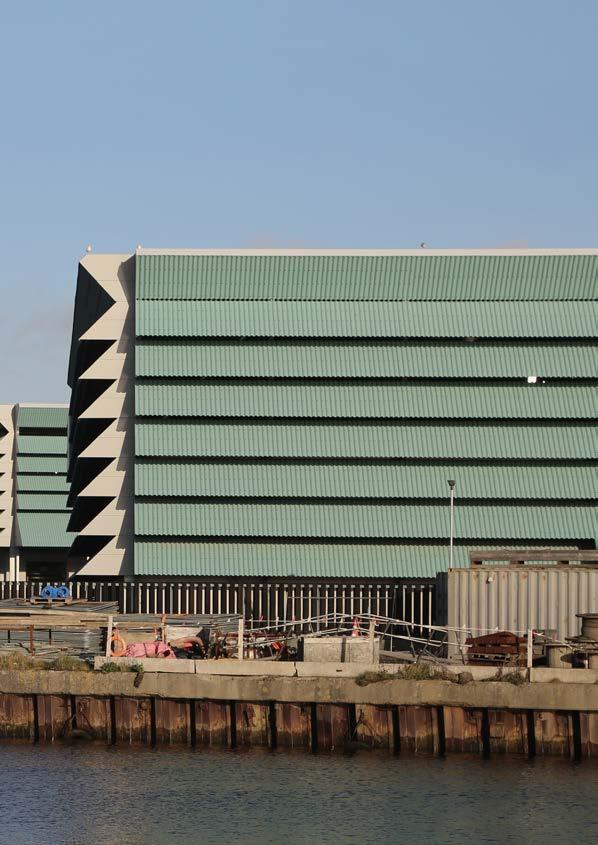

A Case Study of Collaboration and Technical Excellence
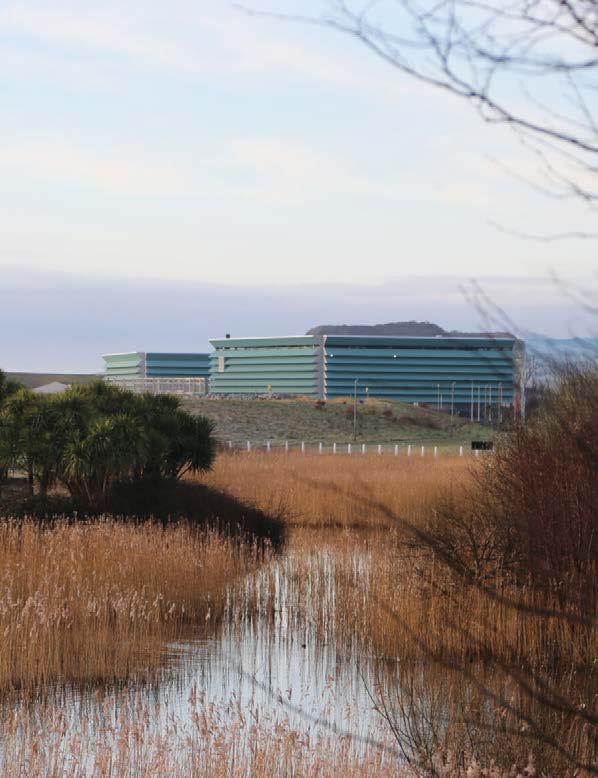



Photo Credit Photograph: Camilla Crafa & Piera Bedin
Arklow Wastewater Treatment Plant
Arklow, County Wicklow, Republic of Ireland
ARKLOW - A HISTORY
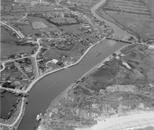
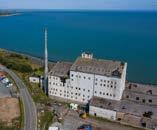
site - previously an ammunition factory and later, a wallboard plant, added complexity to the design and construction process.
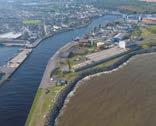
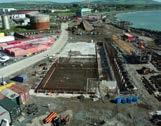
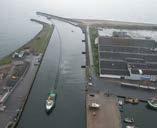
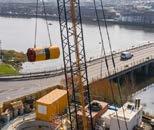
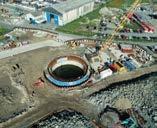
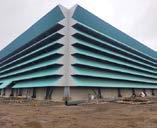
1988 A wastewater treatment plant is first proposed for Arklow.
1993
The proposed site shifts to Seabank, sparking local controversy. Coastal erosion later makes this location unfeasible.
Planning permission is granted for the first time. However, financial constraints, delays and disputes continue into 2000s
2005
A new Environmental Impact Assessment Report (EIAR) is submitted. Planning permission is granted again.
2015
Planning permission expires
2016
Uisce Éireann (then Irish Water) takes over responsibility for the project. ByrneLooby (Ayesa) and Arup undertake design options for sewer and marine outfall
2019
Planning permission is granted by An Bord Pleanála.
2021
Project goes to tender
2021
Construction begins at the North Dock site.
2024
Construction completed in November 2024 - six months ahead of schedule
2025
Commissioned January 2025, six
Figure 1: Arklow Harbour 1951
Figure 3: Aerial View: prior to construction
Figure 2: Proposed
Figure 5: Summer 2022 VanOrd: Carrying out the long Sea Outfall (LSO)
Figure 4: Arklow Wastewater Treatment Plant Site Summer 2022.
Figure 6: The tunnel boring machine being launched into the underground shaft.
Figure 8: The design took design cues from the Sydney Opera House
Figure 7: Construction of the Inlet Pumping Station Summer 2022.
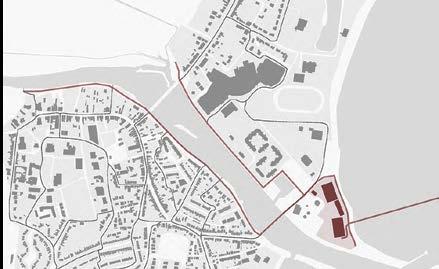
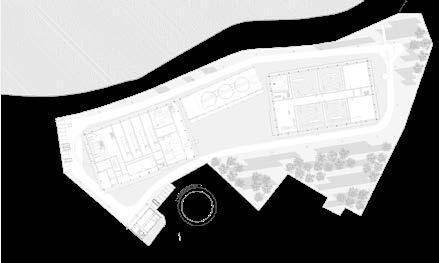
Drawings 2: Arklow Ground Floor Plan
ahead of schedule
Drawings 1: Arklow Site plan
DRAWINGS
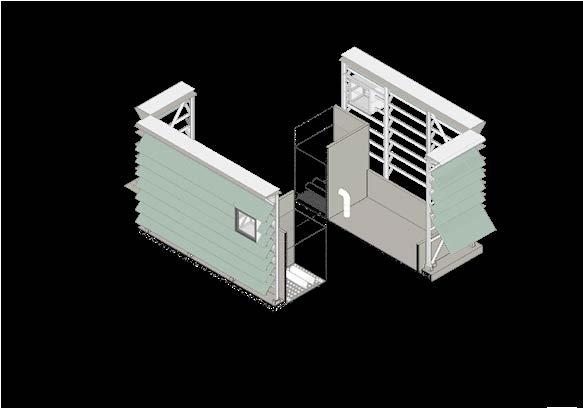
Drawings 3: Arklow Axonometric Detail Section
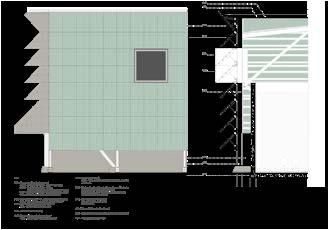
Drawings 4: Arklow Detail Construction

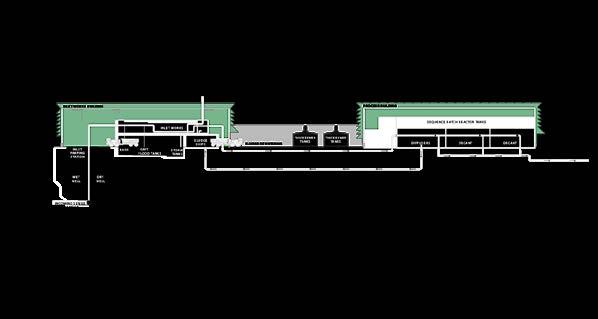
Drawings 5 : Process and Inlet Works Buildings
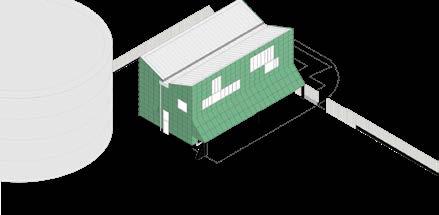
Drawings 6 : Axonometric Administration Building
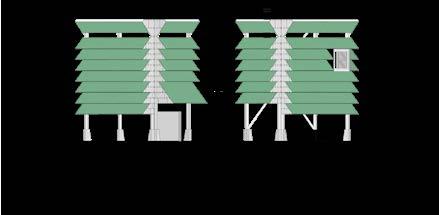
Drawings 7 : Axonometrics
A CASE OF EXCELLENCE, COLLABORATION & BEST
ARKLOW WWTP
Final Outcome
The Arklow Wastewater Treatment Plant marks a transformative milestone for Ireland’s water infrastructure—ending decades of raw sewage discharge into the Irish Sea and bringing the town of Arklow into full compliance with EU environmental directives. Delivered on a legacy industrial site with challenging planning history, it combines engineering innovation, architectural integration, environmental recovery, and deep community engagement. This project was delivered six months ahead of schedule and sets a global benchmark for sustainable civic infrastructure.
Project Background & Execution
Originally proposed in 1988, the Arklow Wastewater Treatment Plant was delayed for decades due to lapsed planning, site disputes, and stakeholder challenges. Uisce Éireann resumed leadership in 2016, granting planning in 2019, with construction commencing in 2021. Delivered under a Design-Build-Operate model, the €139 million project includes an advanced treatment facility, marine outfall, and extensive sewer network. The facility has an initial 24,000 PE capacity, scalable to 36,000 through modular upgrades. Despite its complexity, the project was delivered six months early, thanks to meticulous planning, robust collaboration, and strategic risk management.
Innovation & Design
This project redefines what a wastewater treatment plant can be—low-energy, above-ground design avoids disturbing contaminated soils and relies on gravity-assisted flow, reducing pumping energy. Clancy Moore Architects and Ayesa created a facility that integrates seamlessly into its maritime setting. Passive ventilation, bird and bat habitats, and rooftop PV panels are just some of the innovations. The marine outfall was delivered using a float-and-flood method, with cutting-edge hydrodynamic modelling ensuring optimal location and performance. This is the first utility project to receive the prestigious AAI Downes Medal.
Sustainability & EHS&S
Sustainability was embedded across every aspect of the Arklow Wastewater Treatment Plant—from energy use and materials to biodiversity and community wellbeing.
Energy Efficiency: The plant uses a single-lift pumping system supported by gravity flow, significantly reducing energy consumption. Rooftop solar PV panels further offset operational demand.
Circular Economy: Designed for modular expansion with minimal ground disturbance, the plant avoids excavation in contaminated soils and supports long-term adaptability.
Environmental Health & Safety (EHS): The project maintained an exemplary health and safety record, supported by real-time monitoring of noise, vibration, and air quality, alongside robust controls and community safeguards.
Biodiversity: 30% of the site is dedicated to rewilding, while the louvred building design provides habitat for bats and local species. Durable, non-toxic materials were selected to reduce environmental impact and ensure longevity.
Odour & Emission Control: The innovative architectural design naturally supports passive ventilation and effective odour management, maintaining air quality for both workers and nearby residents.
Community Impact: The facility eliminates raw sewage discharge, vastly improving water quality in the Avoca River and Irish Sea— restoring marine ecosystems and protecting public health.
This project sets a new standard for sustainable civic infrastructure in Ireland, demonstrating how engineering and environmental care can go hand-in-hand.
Operational Excellence
The Arklow Wastewater Treatment Plant sets a new benchmark for efficiency, resilience, and performance in municipal infrastructure. Engineered for long-term operational success, the plant delivers a highly optimised layout, low-energy processes, and robust structural integrity—all while minimising whole-life costs and environmental footprint.
Efficient Delivery: The project was delivered in 40 months (September 2021 to January 2025), six months ahead of schedule— despite complex site conditions, marine works, and legacy infrastructure constraints.
Low-Energy Operation: The plant’s vertically stacked treatment processes are powered by a single-lift pumping system, with gravity assisting downstream flows—minimising energy use and maintenance.
Energy Performance: The plant consumes approximately 1,400,000 kWh/year, with 160,180.3 kWh/year generated by on-site
rooftop solar PV panels—offsetting operational demand and contributing to Ireland’s climate goals.
Built to Last: The structure incorporates 19,280m³ of concrete, 2,300 tonnes of reinforcement steel, and 760 tonnes of structural steel, ensuring long-term durability in a marine-influenced environment.
Network Integration: Includes 1,200 metres of interceptor sewer tunnelling, a 1,000-metre offshore outfall, and 360 metres of new wave defences, enhancing flood resilience and connecting the full wastewater catchment.
Smart Design: Occupying 12,234m , the facility makes highly efficient use of space by avoiding deep excavations and instead concentrating key processes above ground, mitigating contamination risk from legacy pollutants.
Through a combination of smart engineering, low-carbon design, and resilient construction, the Arklow facility not only meets today’s environmental and regulatory needs—it is future-ready.
Client Satisfaction & Collaboration
Uisce Éireann praised the collaboration across Ayesa, Ward & Burke, and Clancy Moore Architects. Ayesa’s deep understanding of Arklow’s full water cycle (having also delivered the town’s Flood Relief and Water Supply schemes) enabled seamless integration and strategic foresight. Local engagement was constant through Community Liaison Officers and digital platforms. Local councillors supported student tours, and the project was lauded by the Minister for Housing as a catalyst for housing, jobs, and business growth.
People Development & Training
The project prioritised local employment and inclusion, with female engineers from Ayesa leading key delivery roles—a milestone for representation in civil engineering. Construction teams benefited from quarterly CIF safety training and Uisce Éireann’s “Time to Talk” wellbeing programme. STEM outreach, placements, and educational site visits embedded the facility within the local learning environment, inspiring future generations.
Digital Integration
The project applied digital tools like InfoWorks ICM for catchment modelling, marine hydrodynamic simulations, and 3D design reviews to validate complex underground and marine works. BIM coordination ensured clash detection, sequencing, and lifecycle planning—especially crucial for above-ground vertical process layouts on a constrained site. Real-time monitoring dashboards were implemented to track noise, vibration, and air quality.
Community-Led Design & Public Acceptance
Gaining community acceptance was essential to the success of the Arklow Wastewater Treatment Plant—particularly given the site’s central location, long planning history, and legacy of public resistance to earlier proposals. From the outset, the project team placed community consultation at the heart of the design and delivery process.
Early Engagement: Before a single foundation was laid, Ayesa, Clancy Moore Architects, and Uisce Éireann facilitated a series of collaborative design workshops with residents, local councillors, and business stakeholders. These sessions captured local insights, values, and aspirations—shaping both the engineering and architectural response.
Contextual Architecture: The final design reflects Arklow’s maritime heritage, with teal-clad buildings echoing local fishing boats and estuarine colours. Carefully positioned windows frame views of the town, helping the plant feel integrated—not imposed—within the urban landscape.
Open Communication: A dedicated Community Liaison Officer was appointed throughout construction, supported by an online platform and public updates. This ensured transparency, reduced disruption, and helped foster public trust.
Minimising Impact: Construction activities were carefully managed to reduce noise, dust, and traffic disruption. Real-time monitoring data was shared with residents to demonstrate accountability and environmental responsibility.
A Civic Landmark: By treating infrastructure as civic architecture, the project has transformed perceptions. No longer viewed as a hidden utility, the facility is now regarded as a local asset—visibly contributing to environmental protection and community wellbeing.
This inclusive, community-led approach ensured that the plant was not only accepted but embraced by the people of Arklow, setting a powerful precedent for future public infrastructure projects.
PROJECT DELIVERY
GATES 1 & 2: DESIGN OF PEFERRED ROUTES
Ayesa, working in collaboration with Arup, developed the preferred design for the new interceptor sewers that would transport wastewater to the plant and the outfall pipe that would safely discharge treated effluent into the Irish Sea. This phase was highly complex, requiring detailed hydraulic modelling, environmental impact assessments, and strategic stakeholder engagement. Stakeholder coordination, assisting Uisce Éireann (Irish Water) with Compulsory Purchase Orders (CPOs), Utility diversions, landowner agreements, and presenting at the Environmental Impact Statement oral hearing. One of the most challenging aspects of the design was selecting the best route for the interceptor sewers. The topography of Arklow and the termination of all outfalls at the river provided only two viable locations for these sewers—at the North and South Quays. This required the construction of a tunnel pipeline linking both sides, allowing wastewater to be transferred to the new plant.
DETAILED INHOUSE MODELLING, ASSESSMENTS UNDERPIN DESIGN
Ayesa undertook Hydraulic and environmental analysis using InfoWorks ICM, an advanced integrated catchment modelling tool, to determine optimal sewer alignments.
Ayesa conducted comprehensive surveys and assessments, including flood risk assessments, site investigation works, bathymetric surveys, structural surveys, flow & load, rainfall monitoring, topographical mapping, marine studies, noise assessments, and ecological impact evaluations.
STAKEHOLDER CONSULTATION
Ayesa assisted Uisce Éireann (Irish Water) with Compulsory Purchase Orders (CPOs), Utility diversions, landowner agreements, and presenting at the Environmental Impact Statement oral hearing.
OUTFALL-INTAKE SELECTION & LSO
Ayesa and Arup conducted a series of feasibility studies to evaluate whether a river or marine outfall would be more appropriate. Hydrodynamic and water quality modeling revealed that a river discharge would pose operational and environmental challenges, making a marine outfall the best option. Several route options were analyzed, leading to a cost-efficient solution that reduced the length of the outfall. The final design incorporated a 900m pipeline, carefully positioned to account for: Flow currents in Arklow Bay, Proximity to beaches and sensitive marine environments, Existing infrastructure, including a General Electric (GE) sub-sea electricity cable.In September 2022, the onekilometre sea outfall off Arklow, Co. Wicklow was completed. Designed by Royal HaskoningDHV for Van Oord Ireland Ltd, the 630mm diameter HDPE pipeline extends approximately 927 metres offshore to a discharge point in 13 metres of water. The outfall ends in a diffuser with six 355mm risers and four 160mm ports, each fitted with duckbill valves for even horizontal dispersion about one metre above the seabed. Installed using float-and-flood, the pipeline was stabilized with 290kg/m concrete collars and 2.3-tonne concrete kennels spaced every 3.5 metres, ensuring a submerged specific gravity over 1.35. The trench was backfilled with side-cast material, maintaining a minimum 1.5m cover depth under changing seabed conditions and potential anchor drag. Installation faced challenges including limited port access, weather constraints, and variable seabed conditions like coarse soils and buried boulders. Magnetometry and unexploded ordnance (UXO) surveys helped mitigate risks. Special care was taken to avoid impacting a nearby subsea power cable supplying the Arklow Bank Wind Farm. The project involved Ward & Burke (main contractor), Van Oord Ireland Ltd (marine works), Royal HaskoningDHV (design), Pipelife Norge AS (pipe), and Tracey Concrete (collars and kennels), Pipelife Norge AS (pipe), and Tracey Concrete (concrete collars and kennels).
GATES 3 & 4: CONSTRUCTION AND DELIVERY
With planning, land acquisition, and environmental licenses secured, Uisce Éireann (Irish Water) appointed Ward & Burke as the contractor for the scheme. Following a competitive tender, Ayesa was selected as Employer’s Representative, providing contract administration and overseeing project delivery.
CONSTRUCTION MILESTONES
• Completion of the underground tunnel pipeline & shafts along the North Quay for the new interceptor sewer.
• Progress on the river-crossing tunnel and installation of the South Quay interceptor sewer.
• Installation of the 1000m offshore outfall pipeline, which was transported in three 310m sections from Norway and submerged in June 2022.
• A pumping station with a design capacity of 304 liters/sec, with capacity to serve up to 36,000 PE.
• Tunnelled pipeline under the Avoca River using advanced TBM technology.
A RADICAL DESIGN OF WWTP INFRASTRUCTURE
This project is the result of a true collaboration — between the people of Arklow and the project design team (architects, engineers and contractors) to deliver a piece of civic infrastructure rooted in memory, form, and the future of the town. In early consultations and design workshops, local knowledge, history, and aspirations were gathered and shared. These community conversations shaped the design approach, resulting in a facility that responds not only to environmental and technical needs but to cultural and civic values as well.
The site, long associated with industry and employment, became a canvas for a new kind of public architecture. Clancy Moore Architects won Uisce Éireann’s design competition with a proposal that embedded the treatment plant into the fabric of the town — acknowledging its maritime setting and industrial past while setting a forward-looking tone. The outcome is a radical reinvention of the typical wastewater treatment facility: a building that serves the public good while embodying local narratives and memories.
Located on the site of a former munitions and wallboard factory, the design embraces the character of historic industrial buildings — combining functionality with architectural nuance. Instead of concealing the plant behind visual barriers, The project team created a striking composition of two elongated, low-slung volumes, set at an angle to reduce their perceived scale. Clad in teal corrugated fibre cement — chosen to reflect the hues of Arklow’s fishing boats, local sports teams, and coastal flora — the building’s louvred façades are engineered to promote natural ventilation and soften the visual impact over time. This layered cladding system, along with carefully modulated structural proportions, ensures the building is visually engaging at both civic and human scale.
The result is a compact, low-energy approach to wastewater infrastructure. All treatment processes are placed above ground, avoiding the disturbance of pollutants left by the site’s former industrial use, with no need to remove soil. The processes are vertically stacked to minimise site coverage, and unlike a conventional plant that requires multiple energy-intensive pumps, this system relies on a single pump with gravity assisting the remaining flow — significantly reducing energy demand. To service the stacked forms, a gantry crane runs along the roof, which also hosts a PV solar farm to offset energy use.
The main treatment functions are housed in two primary volumes, each clad in a louvred skin that distributes air, controls odour, and screens operations from public view. This design not only supports future upgrades for a growing town population of up to 36,000 people, but also contributes ecological value: the louvres provide habitats for bats and birds, and the compact footprint allows much of the remaining site to be rewilded with native species if required. The louvred façades shift in character with the weather and time of day, offering a changing visual experience from afar and up close. A smaller laboratory building anchors the street edge, supporting a more urban future for the site, while the entire scheme helps restore access to the polluted Avoca River and coastline — a long-term investment in community health and wellbeing. Now complete, the plant enables the sustainable development of the town alongside clean waters — both river and sea. It sets an optimistic future for Arklow and signals the potential for Ireland’s urban and infrastructural development to deliver care, excellence, and innovation.
PROJECT DELIVERY
MATERIALS AND SUSTAINABILITY
The design makes thoughtful use of durable, low-maintenance materials that respond to both environmental and cultural context. The primary structure is formed from reinforced concrete, creating robust tank walls and base elements. From these, steel portal frames rise to support the superstructure. The main process buildings are clad in custom-coloured Swisspearl Ondapress 57 fibre cement panels, selected for their durability and reflecting Arklow’s coastal setting—echoing local fishing boats and sporting colours. The entrance laboratory uses matching Swisspearl Carat flat panels. While concrete and steel are carbon-intensive at the point of manufacture, their long lifespan and structural resilience make them essential for infrastructure of this scale and complexity. The design mitigates embodied carbon through a compact, efficient layout that reduces the building’s footprint, avoids ground disturbance on a polluted site, and makes use of gravity-assisted flows to minimise energy demand. Solar PV panels on the roof further offset operational energy. The use of fibre cement cladding, a non-toxic, recyclable material with a long service life, also contributes to a lower whole-life carbon impact. Together, these strategies support a low-energy, low-maintenance future
TAKING STAKEHOLDERS ON THE JOURNEY & SAFE CONSTRUCTION
Several strategies were implemented to ensure smooth integration within the town:
Traffic Management: Diversion routes, coordinated deliveries, and road upgrades were designed to minimize disruption for residents and commuters.
Noise and Vibration Management: A detailed Noise and Vibration Management Plan (NVMP) was established, including real-time monitoring of noise, vibration, and air quality. Measures such as using quieter equipment, noise barriers, and limiting working hours (7 am – 7 pm on weekdays) helped protect the environment and local residents.
Community Liaison: Dedicated Community Liaison Officers engaged with locals, providing updates and addressing concerns throughout the project. A centralized online platform facilitated data sharing and ensured stakeholders stayed informed.This approach successfully minimized environmental impact and fostered a positive relationship between the project and local residents.
Equality, Diversity & Inclusion: Local recruitment was prioritised, with female engineers from Ayesa leading the project management team — marking a significant shift in civil engineering representation.
Health, Safety & Wellbeing: The project maintained an exemplary safety record, supported by quarterly Construction Industry Federation training, wellbeing programmes, and Uisce Éireann’s “Time to Talk” mental health initiative. Breakout sessions helped destigmatise mental health issues among construction teams.
Education & Skills Development: The project supported Uisce Éireann’s STEM outreach by offering students and young engineers site tours and placements. Local councillors facilitated visits, embedding the plant in the community’s educational fabric.
ECONOMIC & SOCIAL BENEFITS
Environmental Protection: Eliminates raw sewage discharge, significantly improving water quality in the Avoca River and the Irish Sea, restoring marine ecosystems and biodiversity.
Flood Resilience: Includes emergency overflow structures at the plant and South Quay to manage extreme weather events and prevent local flooding, enhancing community safety and resilience.
Urban Integration: Thoughtful architectural design ensures the plant is visually and structurally compatible with the surrounding townscape, reflecting Arklow’s maritime heritage and fostering civic pride.
Economic Growth: Provides essential infrastructure to support residential and commercial expansion in Arklow and the wider region, attracting investment and creating jobs.
Civic Infrastructure Enhancement: The plant transcends its role as a utility to become a cherished community landmark. Extensive public consultation helped shape a facility that reflects and strengthens Arklow’s identity, improving residents’ quality of life. Thoughtfully placed windows invite locals to engage with the plant, offering framed views of the town and fostering a unique connection between the community and its infrastructure.
Energy Efficiency and Sustainability: Vertical treatment processes, single pump lift system, and rooftop solar PV reduce energy consumption and carbon footprint, aligning with Ireland’s climate goals.
Biodiversity and Green Space: Rewilding 30% of the site promotes local flora and fauna, contributing to urban green space and ecological networks.
PROJECT STATS
• Total time on site: Sept 2021 to Jan 2025 – 40 months
• Total length of interceptor sewer tunnelling: 1200 metres
• Total length of new wave defences: 360 metres
• Operational energy: the energy use of the plant kWh/year APPROX 1,400,000 kWh/year
• Concrete: 19,280m3 of concrete
• Steel Reinforcement: 2,300 tonne reinforcement
• Structural Steel: 760 tonne structural steel
• Total kWh/year of PV electricity power generation on site: 160,180.3 kWh/year
Project Details
• Area: 12,234 m²
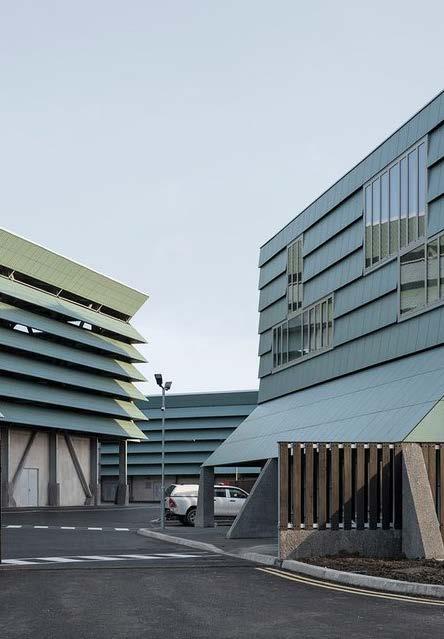
KEY STATISTICS
PRESS CUTTINGS
• Arklow Wastewater Treatment Plant Shortlisted for RIAI Public Choice Award 2025 | News Updates | Uisce Eireann
• https://www.surfacemag.com/articles/arklow-ireland-waste-treatment-plant/
• Downes Medal Winner: https://architecturalassociation.ie/aai-announces-2025-awards-winners-2/
• https://www.ribaj.com/buildings/arklow-wastewater-treatment-plant-clancy-moore-architects-infrastructure-ireland
• https://www.waterindustryjournal.co.uk/new-treatment-works-attract-international-praise
• Sustainability in Architecture: https://www.riai.ie/whats-on/news/riai-awards-2025-results
• https://smartwatermagazine.com/news/smart-water-magazine/eu139-million-wastewater-treatment-plant-officially-opens-arklow-ireland
• https://architecturetoday.co.uk/arklow-wastewater-treatment-plant/
• https://www.businessmanchester.co.uk/2025/05/20/arklow-wastewater-plant-sets-new-standard-for-sustainable-infrastructure/
• https://www.ribaj.com/buildings/arklow-wastewater-treatment-plant-clancy-moore-architects-infrastructure
• https://www.facebook.com/VirginMediaNews/videos/it-may-not-sound-glamorous-but-a-new-wastewater-treatment-plant-in-arklow-is-dra/2074939399672714/
• https://www.archdaily.com/1029788/arklow-waste-water-treatment-plant-clancy-moore-architects
• https://www.irishtimes.com/culture/art/2025/04/05/how-arklow-turned-a-major-sewage-problem-into-an-opportunity-to-build-something-spectacular/
• https://www.theguardian.com/artanddesign/2025/apr/04/arklow-sewage-works-treatment-plant-ireland-clancy-moore-architecture
• https://www.znewsservice.com/entertainment/ayesas-arklow-wastewater-plant-raises-the-bar-for-sustainable-infrastructure-in-ireland/20098/
• https://www.theguardian.com/artanddesign/2025/apr/04/arklow-sewage-works-treatment-plant-ireland-clancy-moore-architecture
• https://www.surfacemag.com/articles/arklow-ireland-waste-treatment-plant/
• https://www.ehn.org/a-sewage-plant-with-sea-views-helps-transform-one-irish-towns-future
• https://www.businessmole.com/arklow-wastewater-plant-opens-a-landmark-in-sustainable-infrastructure-led-by-ayesa/
• https://www.water.ie/news/taoiseach-and-housing-minister-officially-open-landmark-arklow-wastewater-treatment-plant
• https://www.theguardian.com/artanddesign/2025/apr/06/arklow-wastewater-treatment-plant-ireland-review-clancy-moore-a-sewage-plant-youd-be-happy-to-live-next-door-to
• https://www.architectural-review.com/buildings/out-of-the-sewer-wastewater-treatment-plant-in-arklow-ireland-by-clancy-moore
• https://architecturetoday.co.uk/arklow-wastewater-treatment-plant/
• https://www.independent.ie/regionals/wicklow/arklow-news/arklow-wastewater-treatment-plant-shortlisted-for-prestigious-award/a437216441.html
• https://www.independent.ie/regionals/wicklow/arklow-news/commissioning-of-arklow-wastewater-treatment-plant-hailed-by-td-brian-brennan/a919834921.html
• https://www.watermagazine.co.uk/2025/06/12/arklow-wastewater-treatment-plant-in-ireland-shortlisted-for-riai-public-choice-award-2025/
• https://www.irishtimes.com/culture/art/2025/04/05/how-arklow-turned-a-major-sewage-problem-into-an-opportunity-to-build-something-spectacular/
• https://www.eastcoast.fm/news/wicklow-news/aesthetically-pleasing-new-arklow-wastewater-treatment-plant-earns-national-recognition/
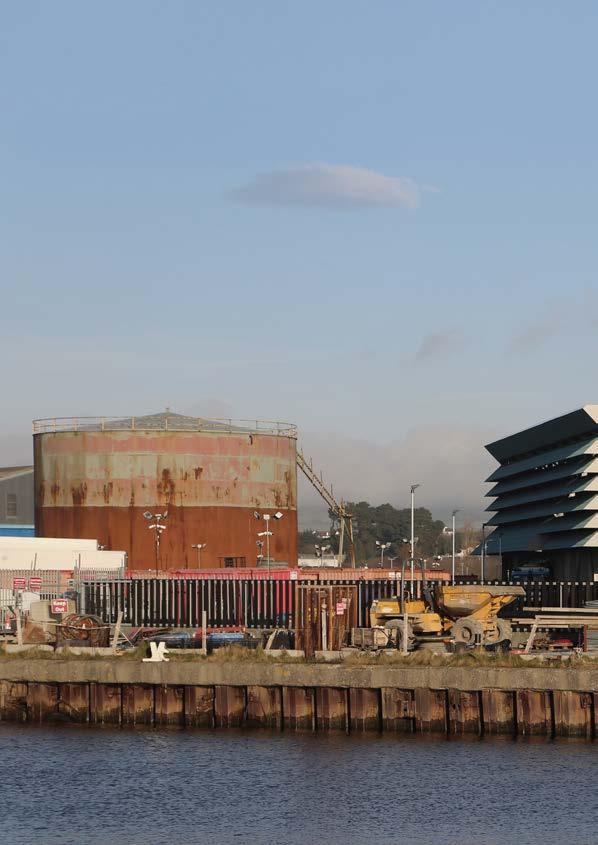
https://www.facebook.com/VirginMediaNews/videos/it-may-not-sound-glamorous-but-a-new-wastewater-treatment-plant-in-arklow-is-dra/2074939399672714/
https://www.irishtimes.com/culture/art/2025/04/05/how-arklow-turned-a-major-sewage-problem-into-an-opportunity-to-build-something-spectacular/
https://www.theguardian.com/artanddesign/2025/apr/06/arklow-wastewater-treatment-plant-ireland-review-clancy-moore-a-sewage-plant-youd-be-happy-to-live-next-door-to
https://www.independent.ie/regionals/wicklow/arklow-news/arklow-wastewater-treatment-plant-shortlisted-for-prestigious-award/a437216441.html https://www.independent.ie/regionals/wicklow/arklow-news/commissioning-of-arklow-wastewater-treatment-plant-hailed-by-td-brian-brennan/a919834921.html
https://www.irishtimes.com/culture/art/2025/04/05/how-arklow-turned-a-major-sewage-problem-into-an-opportunity-to-build-something-spectacular/
